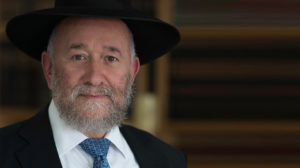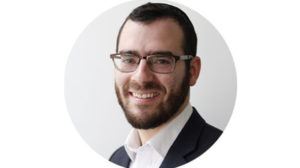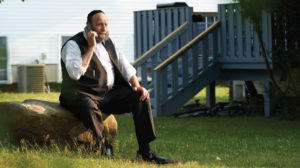Wings for Every Child

Esther Gutwein started her career as graduate student doing psychological evaluations. Today she manages education supervisors. Throughout it all, she’s strived to help every child succeed

E
very Jewish parent wants his child to succeed in school. With some kids that’s a no-sweat proposition; they take to school with the ease of birds taking flight. Others however just can’t seem to lift off the ground.
Figuring out what keeps a child from succeeding in school is the province of the school psychologist. She’s the one who administers the tests that indicate areas of strength or dysfunction. She makes recommendations for addressing any weak spots: resource room speech therapy occupational therapy tutoring. Few yeshivos have their own school psychologists on staff but when a child seems challenged parents in New York have the option to apply to the Department of Education (DOE) for an evaluation and possible therapy.
Mrs. Esther Gutwein has been implementing or overseeing evaluations for the DOE in New York for over 25 years and rose through the ranks to become first a supervisor then a manager of supervisors. This places her almost at the very top of the totem pole for the DOE school psychology department. It’s an impressive accomplishment in a department comprised of nearly 1 000 school psychologists.
But Esther isn’t the type to flaunt her titles or anything else for that matter. A Flatbush mother and grandmother tastefully dressed with a short wig and a bit of makeup she looks like someone you’d sit next to in shul or run into at a shidduch meeting. She’s warm and welcoming yet dignified and discreet.
The mantel of her home is decorated with old family photos which give a clue to the family background that shaped Esther. Two remastered photos of her father’s parents take pride of place for a special reason: “My father was one of the first Jews captured during the war and one of the last to be released ” she says. “He was from Belchatow Poland outside Lodz and during the entire war he kept those photos hidden in the sole of his shoe. They were so precious to him that when the shoe fell off in front of the Germans he ran out of line to retrieve it. One of the Germans was about to shoot him but his comrade said ‘If that Jew is so crazy he’d risk his life to run after it just let him be.’ ”
Esther’s father and one of his siblings survived the war; so did her mother and one of her siblings. Esther was born in Frankfurt-am-Main but her parents came to the US when Esther was two and settled in Boro Park.
Her father worked in Manhattan in real estate putting in long days and losing many hours to the commute. Ultimately he decided to move the family to the West Side in order to have more time with them. His distinguished personality left a deep mark on Esther. “He was wealthy before the war ” she relates “but he used to tell us ‘There are three things no one can ever take away from you: the emunah and love you have in your heart and the knowledge you have in your brain.’ For my parents education was everything.”
Her parents made sure their children were educated; by the time Esther got married she’d earned a bachelor’s degree in psychology and a Hebrew teacher’s certificate. She wasn’t intending to go to work; she wanted to raise a family. When that didn’t work out right away she decided to go back to school for graduate work training as a school psychologist.
She began working for Counterforce, a division of Torah Umesorah that provides counseling and testing services for yeshivah and day-school students. The Department of Education also hired her briefly on a per diem basis, as they were dealing at the time with litigation around special education and needed people to help with testing. “They were so in need of school psychologists they hired people still finishing graduate school, myself included,” Esther says.
When she began having children, she stayed home in Forest Hills to raise them; the family moved to Flatbush when her twin sons began first grade. As the kids were all old enough for a full school day, Esther returned to working with Counterforce — at Lev Bais Yaakov, Bais Yaakov of the Lower East Side, and Sarah Schenirer High School.
It was meaningful work, but demanding. The job was rendered all the more difficult because her clientele was right in her own backyard, and it was very delicate to tease out the professional from personal and community ties. Esther decided to take a break and look for something part-time.
“My husband actually found my job,” she relates. “He went to shul and saw someone he knew who worked for the DOE. The man turned out to be an educational evaluator, not a psychologist, but he offered to forward my rיsumי to the right channels.
“I was lucky. It turns out there was a school psychologist who was looking to share her job with someone because she had a sick child, so we both were able to have part-time work.”
By the following fall, the DOE made it clear that the position was meant to be full-time, and one of them would have to leave. But Esther didn’t have to fight for the job. Her colleague chose to leave and take care of her child. That was over 25 years ago. “Today, it’s not so easy to get into the DOE,” she remarks.
Day in the Life
The term “school psychologist” conjures an image of a therapist, listening to children’s problems with a box of tissues on hand. But Esther soon relieves me of that misconception. “If a child needs therapy, the DOE provides it through social workers or psychologists at the school,” she says. “Often a child will be referred to an outside therapist. But the whole family has to be on board, and a regular public school can’t always accomplish that. The system isn’t geared to give many hours of therapy to a single student.”
Instead, what Esther terms “the bread and butter” of a school psychologist is testing, primarily intelligence testing, using instruments such as the Wechsler or the Stanford-Binet IQ test. These measure children’s aptitude to succeed in school. Another test, the Woodcock-Johnson, measures a child’s academic level — which grade level his skills correspond to. There are also projective tests such as the TAT, Rorschach, and figure drawing, in which children’s concerns are interpreted through the way they perceive ambiguous pictures or sketch their world. “Those help give a flavor of the child,” Esther says. “But we don’t use them much these days.”
While all of these tests have been in existence for many years, their use has become all the more necessary for compliance with federal IDEA legislation (Individuals with Disabilities Education Act), which mandates that schools provide appropriate education for all students, regardless of cognitive level or disabilities. The act was later supplemented by the Child Find mandate, requiring schools to identify children with special needs, beginning at birth and continuing through age 21.
“Often a pediatrician is the first person to pick up on a child’s disability,” Esther says. “Parents usually come to us first, but legally, the onus is on us to identify children with special needs.”
Children before age three are eligible for Early Intervention programs in the home; after that, they receive extra help in the schools. An IEP (Individualized Education Program) team, comprised of special education teachers and a psychologist or social worker, is assigned to the child. In New York, a special arm of the DOE handles children in yeshivos, parochial schools, and charter schools. A child up to age five will be evaluated in the district where he lives; after that, the evaluation will be handled by the team of the district where he attends school.
Frum parents have become quick to seek services for their children, a phenomenon that astonishes Esther. “Years ago, the Jewish community rarely brought children in for evaluations,” she says. “Now it’s a standard part of bungalow colony chat to talk about one’s child getting speech therapy or occupational therapy. It’s almost a badge of honor for some people.”
In fact, she notes that frum parents are so anxious to help their children succeed that if anything, they tend to overuse the system. She cautions that accepting services for a child who doesn’t need them is an abuse of the system and a chillul Hashem. “It’s a tragedy, when so many children need services, if the help goes instead to children who don’t really need it,” she says, adding that it’s not exclusively a problem of the frum community. Many large families are happy to have a therapist come to the home and act as a homework helper or babysitter when the parents are overwhelmed.
She has seen cases of parents who applied for special services claiming their children had nonexistent speech issues, or trouble fastening small buttons, or imaginary handwriting problems. “One parent requested physical therapy for a child through the DOE because she didn’t want to pay the copay at a medical office,” Esther recalls. “But the child had an injury that had nothing to do with her ability to perform in school.”
She points out that DOE psychologists can only recommend services for issues related to the ability to learn in school. They’re not there to handle other issues, even though emotional issues clearly take a toll on a child’s ability to learn. Of course, an astute school psychologist will take these into consideration when making her recommendations.
“We had a five-year-old who was very bright, and had all the necessary pre-academic skills to enter kindergarten,” Esther recalls. “She’d been in foster care and went through many traumas and separations from caregivers, and had been placed in special ed the year before. The team originally wanted to mainstream her, putting her in a regular class, but the foster mother objected: She said the child needed more nurturing before she would be ready to learn, that she needed to be in a warm, protected environment where she’d feel safe and secure. The foster mother was right! We worked out a solution for her.”
When services are denied, parents have the right to appeal the decision at an administrative hearing, and during her career Esther has often been called upon to represent the DOE.
“In Region 6, which includes Crown Heights and Flatbush, there are many frum families,” she says. “I once called a rav for advice on how to handle cases that came from my own community. He advised me to look at each case with honest eyes.”
Sometimes parents are the victims of errors in assigning services or drawing up the IEPs; Esther avows that school staff write up so many of them that errors are bound to occur from time to time.
New Wrinkles
It’s now over 25 years since Esther signed up with the DOE. Has she seen major changes over the years in what children need?
“There’s been an explosion of autism,” Esther says with a shake of the head. “I don’t know why — nobody does. I don’t think it’s because we’re over-diagnosing it.”
There has also been a precipitous rise in the number of children labeled as ADHD or ADD. “We expect children to sit longer hours, and at younger ages,” she says. “Not every child diagnosed as ADHD really has a problem. Sometimes it’s the teachers or the parents who have no tolerance for a kid who needs to move a lot! We are probably overmedicating children for this.”
In general, she believes we put more pressure on both parents and children today than we did in the past. We expect children to be able to sit, read, and write much earlier than in previous generations. We expect their school projects to look picture perfect; Esther has seen homework assignments that demand as much from parents as they do from the children. “My grandson had to do a school project constructing a succah for a school fair, but when I saw the constructions done by the other boys, it was obvious their fathers had done most of the work,” she says.
On the other hand, she maintains that frum children have an easier time than non-Jewish children. “It’s a different world outside our community!” she exclaims. “I don’t just see it in the problems of the children; I hear it in discussions among my colleagues. Children in public schools are much more likely to have unstable family situations, or fathers in jail, or problems with drugs or abuse in the family.”
As a frum woman working in the DOE, however, she’s not completely isolated. “There are ‘pockets’ of areas where you have a lot of frum staff,” she says. “There’s one center with so many religious staff that when they do group lunches they use a kosher caterer.”
Now that she’s a manager, she’ll spend the majority of her day “putting out fires”: dealing with complaints, overseeing projects, monitoring employee productivity, and advising supervisors who may be at a loss for how to handle a situation. She prefers the support aspect of her job — helping her supervisors — to the managerial aspect, which requires number crunching.
“Unfortunately, the higher you go in the DOE hierarchy, the further you go from hands-on contact with the children,” she says. She has taken to doing the data-oriented part of her job later in the afternoon, even if it means working overtime, in order to free herself during the day for more interpersonal work.
But while technically eligible to retire, Esther shows no interest in stopping. She likes being involved and active, and she’s worked hard to get where she is. Esther enjoys a unique opportunity to be a light unto the nations — and to her own community as well.
(Originally featured in Family First Issue 568)
Oops! We could not locate your form.













